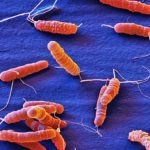Lien vers Pubmed [PMID] – 33229580
Lien DOI – 20201619510.1073/pnas.2016195117
Proc Natl Acad Sci U S A 2020 Nov 23:202016195.
Toxin-antitoxin systems are found in many bacterial chromosomes and plasmids with roles ranging from plasmid stabilization to biofilm formation and persistence. In these systems, the expression/activity of the toxin is counteracted by an antitoxin, which, in type I systems, is an antisense RNA. While the regulatory mechanisms of these systems are mostly well defined, the toxins’ biological activity and expression conditions are less understood. Here, these questions were investigated for a type I toxin-antitoxin system (AapA1-IsoA1) expressed from the chromosome of the human pathogen Helicobacter pylori We show that expression of the AapA1 toxin in H. pylori causes growth arrest associated with rapid morphological transformation from spiral-shaped bacteria to round coccoid cells. Coccoids are observed in patients and during in vitro growth as a response to different stress conditions. The AapA1 toxin, first molecular effector of coccoids to be identified, targets H. pylori inner membrane without disrupting it, as visualized by cryoelectron microscopy. The peptidoglycan composition of coccoids is modified with respect to spiral bacteria. No major changes in membrane potential or adenosine 5′-triphosphate (ATP) concentration result from AapA1 expression, suggesting coccoid viability. Single-cell live microscopy tracking the shape conversion suggests a possible association of this process with cell elongation/division interference. Oxidative stress induces coccoid formation and is associated with repression of the antitoxin promoter and enhanced processing of its transcript, leading to an imbalance in favor of AapA1 toxin expression. Our data support the hypothesis of viable coccoids with characteristics of dormant bacteria that might be important in H. pylori infections refractory to treatment.





